Euro â96 to Euro 2016: Footballâs not coming home, but it has gone digital
05 Jul 2016

When Wes Hoolahan banged in Republic of Ireland’s opener against Sweden, I was on board a Chiltern train somewhere between London and Birmingham streaming it via BBC Sport’s website. I promptly tweeted what I was doing to plain show off (using Twitter’s national flag emoji of course) and could see that #IREvSWE (23.6K tweets) was trending along with #Hoolahan (18.9K) and #MarkLawrenson, who was commentating on the game – and not doing a good job of it, according to the Twitterverse. I must highlight that #Zlatan (61.9K) was also trending, but it’s pretty standard for Zlatan Ibrohimivic to go viral these days, even when he’s not on the field of play.
Streaming, tweeting, trending, emojis, going viral… These are words that wouldn’t have been anywhere near our vocabulary during Euro ’96 twenty years ago. How things have changed since we hosted the same tournament on home soil.
1996 was the year the Internet became a ‘thing’ for much of the population. Windows 95 was being used and the future of Apple was in doubt. Outside of this, DVDs were emerging and digital photography began to trickle into public consciousness. Nobody had a mobile phone – not in my circles anyway.
This obviously impacted how we consumed a major football tournament. We could either watch it at home with family and friends on our analogue TV (not smart, HD or 4K ready) with four terrestrial channels, or we went to the pub to watch it on the big screen (or slightly larger TV). We talked or shouted our thoughts at the screen and then analysed the game afterwards with a drink and some scampi fries. How times have changed.
And now look at us. Bespoke content feeds or bots serve up personalised Euro 2016 content to us just how we want it. We’ve got statistics coming out of our eyeballs that tell us everything we need to know about teams, players, shots, tackles, assists and more. Big data tries to predict results, while a raft of online gambling companies hope we’ll put our money where our mouth is. All while brands are trying to work out how to find an angle and get cut-through with their content.
Some of the best so far include Orange illuminating the Eiffel Tower with the colours of the team who received the biggest support via social media during each game, and Carlsberg using their familiar ‘If Carlsberg did…’ advertising theme to roll out a series of stunts activated online intended to generate significant social buzz. Needless to say bloggers, vloggers and successful digital content creators have likely been secured early by brands to help with digital marketing objectives throughout the tournament. But of course, some brands just got the luck of the draw.
We’ve also seen the power of instant media sharing. A moment caught on camera can instantly be replayed, edited and spread across the internet, ranging from the spectacular (think Boateng’s goal-line clearance in Germany’s opener) to the downright bizarre (Joachim Löw, the German manager, having a scratch down his shorts followed by a sniff). We’ve also seen a YouTube clip of a bloke from Wigan singing an adaptation of popular 1997 hit Freed from Desire. The song about Wigan and Northern Ireland striker Will Grigg consequently went viral and was a popular song at the Euros amongst Northern Ireland and England fans alike.
Does all of this digital content compliment or dilute the watching of a live football broadcast? Well, that’s open to debate. Don’t get me wrong, the vast majority of people would probably still like to watch the game at home or in the pub – but it wouldn’t be without a device in hand through which their thoughts, anger, elation and analysis could be voiced for the world to see in real-time. And how else would you impress your mates with the half-time stats, replay the goals and near-misses and check whether anyone else has noticed that one Irish fan dressed as a leprechaun among a sea of Swedes?
So instead of dwelling on #ENGICE, let’s hark back to ’96 and the content we could have enjoyed: Pearce’s penalty celebration GIF and memes generated off the back of it; streams of Three Lions via Spotify and SoundCloud; Periscopes galore of celebrations around the country after the Dutch victory. I also wonder what would have happened after Gazza’s goal against Scotland and dentist chair celebration in today’s world. They talk about content breaking the internet – I’m pretty sure that moment would have done just that, and left it limping for quite a while afterwards.
_56bb6c6b782e9.png)
Please login to comment.
Comments